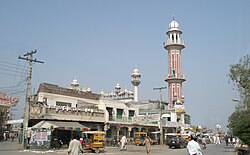Daska
Daska
| |
|---|---|
City | |
| Daska | |
 | |
| Coordinates: 32°20′N 74°21′E / 32.333°N 74.350°E | |
| Country | Pakistan |
| Province | Punjab |
| Division | Gujranwala |
| District | Sialkot |
| Tehsil | Daska |
| Government | |
| • MNA(s) | Syeda Nosheen Iftikhar (NA-69 (Sialkot-IV)) |
| • MPA(s) | |
| Elevation | 217 m (712 ft) |
| Population | |
• City | 175,170 |
| • Rank | 50th, Pakistan |
| Time zone | UTC+5 (PST) |
| Calling code | 052 |
| Number of towns | 1 |
| Postal Code | 51010 |
Daska (Punjabi: ڈسکا; Urdu: ڈسکہ), is a city in the Punjab province of Pakistan. The city is the capital of Daska Tehsil, one of four tehsils of Sialkot District.
Demography
[edit]Daska is ethnically diverse and is home to many different tribes, ethnic Kashmiris and the Rajputs are dominant in the urban area, with a large amount of Pashtuns overwhelmingly from the Kakazai tribe are significant in the urban and rural area having migrated centuries ago. Several Gujjar and Jatt tribes are dominant in the rural areas. Others smaller groups such as the Awan, Arain Khokhars, and Gakhars, there are also found while there is also a large amount of the ethnic Mewati speaking people from Haryana having migrated there during the partition of India.
History
[edit]17th-19th centuries
[edit]Daska was founded during the reign of Shah Jahan, and was initially named Shah Jahanabad, according to Mughal revenue records.[2] It was later renamed Daska as it is das ("ten") koh (Mughal unit of distance) from Sialkot, Pasrur, Gujranwala, and Wazirabad.[3] During the Afghan Durrani invasion of the 18th century, Daska was ruined, and its inhabitants were forced to seek shelter in the nearby mud fort of Kot Daska.[4] Daska was later repopulated during the Sikh era.[5] Daska was captured by Ranjit Singh in 1802 and made part of the Sikh Empire.[6]
20th century
[edit]In 1929, Daska was the site of Hindu-Sikh riots when Akali Sikhs attempted to seize control of Gurdwara Sant Wayaram Singh. The local Hindu community claimed it was originally built to be a Hindu temple.[7]
In August 1947, 5,000 refugees from surrounding areas gathered at Daska Camp for two weeks before being escorted to the Indian border by the Pakistan Army.[8]
Notable People
[edit]- Fazal Idaho (born 1948) - Pakistani politician
References
[edit]- ^ "PAKISTAN: Provinces and Major Cities". PAKISTAN: Provinces and Major Cities. citypopulation.de. Retrieved 4 May 2020.
- ^ Commissioner, Pakistan Office of the Census (1962). Population Census of Pakistan, 1961: Dacca. 2.Chittagong. 3.Sylhet. 4.Rajshahi. 5.Khulna. 6.Rangpur. 7.Mymensingh. 8.Comilla. 9.Bakerganj. 10.Noakhali. 11.Bogra. 12.Dinajpur. 13.Jessore. 14.Pabna. 15.Kushtia. 16.Faridpur. 17.Chittagong Hill tracts.
- ^ Gazetteer of the Jhang District: 1883. 1883.
- ^ Gazetteer of the Jhang District: 1883. 1883.
- ^ Gazetteer of the Jhang District: 1883. 1883.
- ^ bahādur.), Muḥammad Laṭīf (Saiyid, khān (1891). History of the Panjáb from the Remotest Antiquity to the Present Time. Calcutta Central Press Company, limited.
{{cite book}}: CS1 maint: multiple names: authors list (link) - ^ Nijjar, Bakhshish Singh (1996). History of the United Panjab. Atlantic Publishers & Dist. ISBN 978-81-7156-534-4.
- ^ Page, Co-Director Media South Asia Project Institute of Development Studies David; Page, David; Singh, Anita Inder; Moon, Penderel; Khosla, G. D. (2002). The Partition Omnibus. Oxford University Press. ISBN 978-0-19-565850-7.


